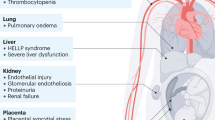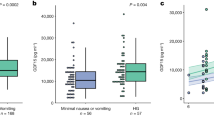Abstract
Objective
Evaluate if odds of survival without major morbidity are higher among extremely low gestation neonates (ELGANs) born to mothers with chronic hypertension (cHTN) or hypertensive disorders of pregnancy (HDP) compared to ELGANs born to mothers without hypertension (HTN).
Study design
Retrospective study of prospectively collected data from the Eunice Kennedy Shriver National Institute of Child Health and Human Development Neonatal Research Network. Included children had a birthweight of 401–1000 g and/or gestational age of 220/7 to 286/7 wks. The primary outcome was survival to discharge without major morbidity. Multivariable regression models were used to compare outcomes among ELGANs born to women with cHTN, HDP, and no HTN.
Results
Survival without morbidities for newborns of mothers with no HTN, cHTN and HDP (29.1%, 32.9%, 37.0% respectively) did not differ after adjustment.
Conclusion
After adjusting for contributing variables maternal HTN is not associated with improved survival free of morbidity among ELGANs.
Trials Registration: clinicaltrials.gov Identifier: NCT00063063 (generic database)
This is a preview of subscription content, access via your institution
Access options
Subscribe to this journal
Receive 12 print issues and online access
$259.00 per year
only $21.58 per issue
Buy this article
- Purchase on Springer Link
- Instant access to full article PDF
Prices may be subject to local taxes which are calculated during checkout

Similar content being viewed by others
Data availability
Data from this active and ongoing registry study can be requested at: https://neonatal.rti.org/index.cfm?fuseaction=DataRequest.Home.
References
ACOG. ACOG Practice Bulletin No. 202 Summary: Gestational Hypertension and Preeclampsia. Obstet Gynecol. 2019;133:211–4.
ACOG. Practice Bulletin No. 203: Chronic Hypertension in Pregnancy. Obstet Gynecol. 2019;133:e26–e50.
Berghella V Obstetric Evidence Based Guidelines. Third Edition ed. Boca Raton, FL: CRC Press Taylor & Francis Group; 2017.
Panaitescu AM, Syngelaki A, Prodan N, Akolekar R, Nicolaides KH. Chronic hypertension and adverse pregnancy outcome: a cohort study. Ultrasound Obstet Gynecol: Off J Int Soc Ultrasound Obstet Gynecol. 2017;50:228–35.
Bramham K, Parnell B, Nelson-Piercy C, Seed PT, Poston L, Chappell LC. Chronic hypertension and pregnancy outcomes: systematic review and meta-analysis. BMJ (Clin Res ed). 2014;348:g2301.
Razak A, Florendo-Chin A, Banfield L, Abdul Wahab MG, McDonald S, Shah PS, et al. Pregnancy-induced hypertension and neonatal outcomes: a systematic review and meta-analysis. J Perinatol. 2018;38:46–53.
McBride CA, Bernstein IM, Badger GJ, Horbar JD, Soll RF. The effect of maternal hypertension on mortality in infants 22, 29weeks gestation. Pregnancy Hypertension. 2015;5:362–6.
Chen XK, Wen SW, Smith G, Yang Q, Walker M. Pregnancy-induced hypertension is associated with lower infant mortality in preterm singletons. Bjog. 2006;113:544–51.
Gagliardi L, Rusconi F, Bellù R, Zanini R. Association of maternal hypertension and chorioamnionitis with preterm outcomes. Pediatrics. 2014;134:e154–161.
von Dadelszen P, Magee LA, Taylor EL, Muir JC, Stewart SD, Sherman P, et al. Maternal hypertension and neonatal outcome among small for gestational age infants. Obstet Gynecol. 2005;106:335–9.
Bell MJ, Ternberg JL, Feigin RD, Keating JP, Marshall R, Barton L, et al. Neonatal necrotizing enterocolitis. Therapeutic decisions based upon clinical staging. Ann Surg. 1978;187:1–7.
Gemmell L, Martin L, Murphy KE, Modi N, Hakansoon S, Reichman B, et al. Hypertensive disorders of pregnancy and outcomes of preterm infants of 24 to 28 weeks’ gestation. J Perinatol. 2016;36:1067–72.
Tokumasu H, Tokumasu S, Kawakami K. Impact of pre-eclampsia in extremely premature infants: Population-based study. Pediatrics Int: Off J Jpn Pediatr Soc. 2016;58:578–83.
Rysavy MA, Li L, Bell EF, Das A, Hintz SR, Stoll B, et al. Between-hospital variation in treatment and outcomes in extremely preterm infants. N Engl J Med. 2015;372:1801–11.
Yusuf K, Alshaikh B, da Silva O, Lodha AK, Wilson RD, Alvaro RE, et al. Neonatal outcomes of extremely preterm infants exposed to maternal hypertension and cigarette smoking. J Perinatol. 2018;38:1051–9.
Rocha G, de Lima FF, Machado AP, Guimarães H. Preeclampsia predicts higher incidence of bronchopulmonary dysplasia. J Perinatol. 2018;38:1165–73.
Thébaud B, Abman SH. Bronchopulmonary dysplasia: where have all the vessels gone? Roles of angiogenic growth factors in chronic lung disease. Am J Respiratory Crit Care Med. 2007;175:978–85.
Grover TR, Parker TA, Balasubramaniam V, Markham NE, Abman SH. Pulmonary hypertension impairs alveolarization and reduces lung growth in the ovine fetus. Am J Physiol Lung Cell Mol Physiol. 2005;288:L648–654.
Shapiro S, Trail-Burns E, Slader MG, Laptook A, De Paepe ME. Correlation between chorionic plate vascularization and risk of bronchopulmonary dysplasia in extremely preterm infants. Placenta. 2020;101:154–8.
Strouss L, Goldstein ND, Locke R, Paul DA. Vascular placental pathology and the relationship between hypertensive disorders of pregnancy and neonatal outcomes in very low birth weight infants. J Perinatol. 2018;38:324–31.
O’Shea JE, Davis PG, Doyle LW. Maternal preeclampsia and risk of bronchopulmonary dysplasia in preterm infants. Pediatr Res. 2012;71:210–4.
Shin SH, Shin SH, Kim SH, Kim YJ, Cho H, Kim EK, et al. The Association of Pregnancy-induced Hypertension with Bronchopulmonary Dysplasia - A Retrospective Study Based on the Korean Neonatal Network database. Sci Rep. 2020;10:5600.
Jensen EA, Dysart K, Gantz MG, McDonald S, Bamat NA, Keszler M, et al. The Diagnosis of Bronchopulmonary Dysplasia in Very Preterm Infants. An Evidence-based Approach. Am J Respiratory Crit Care Med. 2019;200:751–9.
Perger L, Mukhopadhyay D, Komidar L, Wiggins-Dohlvik K, Uddin MN, Beeram M. Maternal pre-eclampsia as a risk factor for necrotizing enterocolitis. J Matern Fetal Neonatal Med. 2016;29:2098–103.
Lucas A, Cole TJ. Breast milk and neonatal necrotising enterocolitis. Lancet. 1990;336:1519–23.
Carlo WA, Finer NN, Walsh MC, Rich W, Gantz MG, Laptook AR, et al. Target ranges of oxygen saturation in extremely preterm infants. N. Engl J Med. 2010;362:1959–69.
Schmidt B, Asztalos EV, Roberts RS, Robertson CM, Sauve RS, Whitfield MF. Impact of bronchopulmonary dysplasia, brain injury, and severe retinopathy on the outcome of extremely low-birth-weight infants at 18 months: results from the trial of indomethacin prophylaxis in preterms. Jama. 2003;289:1124–9.
Bassler D, Stoll BJ, Schmidt B, Asztalos EV, Roberts RS, Robertson CMT, et al. Using a count of neonatal morbidities to predict poor outcome in extremely low birth weight infants: added role of neonatal infection. Pediatrics. 2009;123:313–8.
Goland RS, Jozak S, Warren WB, Conwell IM, Stark RI, Tropper PJ. Elevated levels of umbilical cord plasma corticotropin-releasing hormone in growth-retarded fetuses. J Clin Endocrinol Metab. 1993;77:1174–9.
Acknowledgements
The National Institutes of Health, the Eunice Kennedy Shriver National Institute of Child Health and Human Development (NICHD) and the National Center for Advancing Translational Sciences (NCATS) provided grant support for the Neonatal Research Network’s Generic Database Study through cooperative agreements. While NICHD staff had input into the study design, conduct, analysis, and manuscript drafting, the comments and views of the authors do not necessarily represent the views of NICHD, the National Institutes of Health, the Department of Health and Human Services, or the U.S. Government. Participating NRN sites collected data and transmitted it to RTI International, the data coordinating center (DCC) for the network, which stored, managed and analyzed the data for this study. On behalf of the NRN, RTI International had full access to all of the data in the study, and with the NRN Center Principal Investigators, takes responsibility for the integrity of the data and accuracy of the data analysis. We are indebted to our medical and nursing colleagues and the infants and their parents who agreed to take part in this study.
Funding
Eunice Kennedy Shriver National Institute of Child Health and Human Development, National Institutes of Health, Bethesda, Maryland, USA.
Author information
Authors and Affiliations
Consortia
Contributions
MKW, EW and AL conceptualized and designed the study, drafted the initial manuscript, and reviewed and revised the manuscript. SS contributed to the design of the study, performed initial and subsequent data analysis, and revised the manuscript. SC, MK, EM, and MW contributed to designing the study and critically reviewed the manuscript for important intellectual content. All authors approved the final manuscript as submitted and agree to be accountable for all aspects of the work.
Corresponding author
Ethics declarations
Competing interests
The authors declare no competing interests.
Additional information
Publisher’s note Springer Nature remains neutral with regard to jurisdictional claims in published maps and institutional affiliations.
Supplementary information
Rights and permissions
Springer Nature or its licensor (e.g. a society or other partner) holds exclusive rights to this article under a publishing agreement with the author(s) or other rightsholder(s); author self-archiving of the accepted manuscript version of this article is solely governed by the terms of such publishing agreement and applicable law.
About this article
Cite this article
Kole-White, M.B., Saha, S., Werner, E.F. et al. Maternal hypertensive disorders and survival without major morbidities among extremely low gestation newborns. J Perinatol 43, 430–436 (2023). https://doi.org/10.1038/s41372-023-01631-6
Received:
Revised:
Accepted:
Published:
Issue Date:
DOI: https://doi.org/10.1038/s41372-023-01631-6



